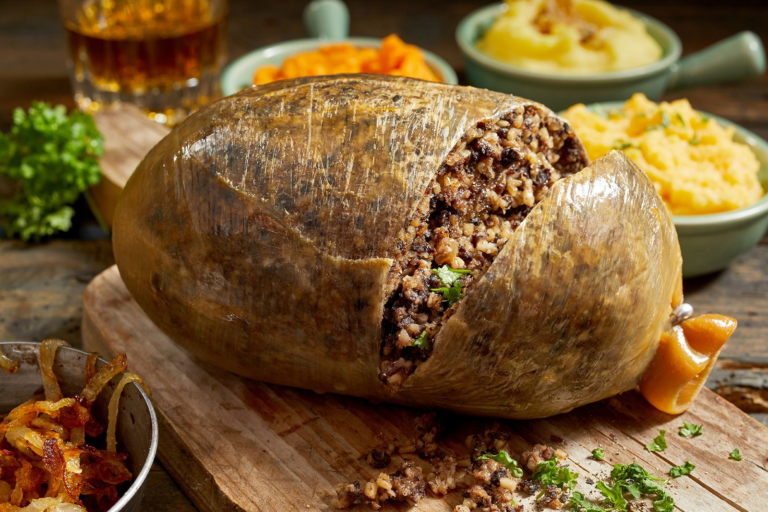Haggis is one of the most unique representatives of Scotland’s cultural and gastronomic heritage. Rather than simply viewing it as a dish, haggis should be seen as a reflection of Scottish identity and traditions. Although it may be misunderstood and approached with prejudice in many parts of the world, haggis has a deep history, an interesting preparation process, and a meaningful story.
What is Haggis?
Haggis is traditionally made by combining minced sheep’s offal (such as liver, heart, and lungs) with finely ground oats, onions, spices, and broth. This mixture is then stuffed into a sheep’s stomach and boiled for a long time. In modern recipes, sausage casings are often used instead of a sheep’s stomach. Haggis is typically served with “neeps and tatties,” which are mashed turnips and mashed potatoes. And of course, it wouldn’t be complete without a splash of whisky sauce on the side!
The History of Haggis
The exact origins of haggis are unknown, but it is believed that the dish became widespread in Scotland during the Middle Ages. The harsh climate and poor soil of Scotland required the people to use meat and offal in the most economical way possible. This necessity led to the creation of practical and nutritious dishes like haggis. The historical traces of haggis are not limited to Scotland alone. Similar offal dishes are known to have existed in other European cuisines as well. However, Scotland stands out for turning this dish into a national symbol, enriched by its cultural context and poetic references.
Robert Burns and Haggis
The place of haggis in Scottish culture was solidified by the famous Scottish poet Robert Burns, who wrote the poem “Address to a Haggis” in 1787. In this poem, Burns praises haggis as a dish that represents the spirit of Scotland, addressing it almost like a hero. As a result, every year on January 25th, Burns Night is celebrated by Scots in honor of Robert Burns’ birthday, with haggis being the centerpiece of the meal. On this night, traditional Scottish poems are recited, songs are sung, and whisky is drunk in tribute to haggis. This cultural ritual highlights the deep connection between haggis and Scottish identity.
How is Haggis Made?
Making haggis is a process that requires patience and care. However, if you follow the traditional method, you can experience this unique flavor in your own home.
Ingredients:
:
- 1 sheep liver, heart, and lungs (offal)
- 1 sheep stomach (or sausage casing)
- 2 cups of finely ground oats
- 2 medium onions, finely chopped
- 1 cup of broth
- 1 teaspoon of salt
- 1 teaspoon of black pepper
- 1 teaspoon of allspice
Instructions:
- First, thoroughly clean the sheep’s offal and boil it in a large pot of water for about 2 hours.
- Remove the cooked offal, let it cool, and then chop or grind it finely.
- In a pan, toast the oats until they turn golden brown.
- In a large bowl, combine the chopped offal, toasted oats, chopped onions, spices, and broth.
- Stuff this mixture into the cleaned sheep’s stomach or sausage casing, but be careful not to overfill it, as it will expand during cooking.
- Place the haggis in a large pot, ensuring it is completely submerged in water, and simmer for about 3 hours over low heat.
The Cultural Significance of Haggis
Haggis is more than just a dish; it is a way to understand the history, culture, and people of Scotland. This dish represents the creative spirit and resilience of the Scottish people, who have lived through centuries of hardship. Haggis also serves as a unifying element in Scottish society, taking center stage during special occasions and celebrations across the country.
For many, haggis may simply be food served on a plate, but for the Scots, it holds much deeper meaning. Haggis is the heart and soul of Scotland, a flavor that bridges the past and the present. Tasting haggis is also a way to understand Scotland’s rich cultural fabric and history. Therefore, knowing the story of haggis and tasting it is one of the most authentic ways to truly experience Scotland.


